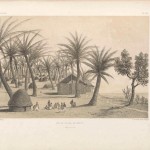Pehr Kalm (1716-1779), a Swedish-Finnish explorer and botanist, was a student of the great naturalist Carl Linnaeus. In fact, Kalm was one of the many “apostles” of Linnaeus sent out to explore the world, and one of the few who didn’t die in the process. To begin the research that later culminated in Travels into North America, Kalm arrived on the continent in 1748. Based in Philadelphia, he worked and traveled with Benjamin Franklin and John Bartram, among others. In his explorations of Pennsylvania and New Jersey and two journeys north through New York to Montreal and Quebec, Kalm formed impressive specimen collections, which Linnaeus subsequently used in naming 90 species of plants, 60 of them new to science, in his Species plantarum (1753). Among those new species, Linnaeus named the mountain laurel genus Kalmia for his disciple.
Tag: Exploration
 The blog post, second of three, was written by Xavier Courouble, research assistant for Sailors and Daughters: Early Photography and the Indian Ocean, an online exhibition part of the Smithsonian’s National Museum of African Art’s Connecting the Gems of the Indian Ocean: From Oman to East Africa. Read the first post in the series here.
The blog post, second of three, was written by Xavier Courouble, research assistant for Sailors and Daughters: Early Photography and the Indian Ocean, an online exhibition part of the Smithsonian’s National Museum of African Art’s Connecting the Gems of the Indian Ocean: From Oman to East Africa. Read the first post in the series here.
From 1836 to 1848, successively in command of the corvette “La Prévoyante,” “La Dordogne,” and finally the frigate “Le Ducouëdic,” Charles Guillain (1808-1875) navigated the Indian Ocean from the Cape of Good Hope to the western coast of the Indian sub-continent. During his several missions he accumulated extensive knowledge on Zanzibar, Madagascar, the Comoros, as well as the Swahili and Somali coast of Africa. Accounts of these expeditions were all published and gave this St. Simonien a solid reputation of ethnologist and geographer. Yet a certain degree of confusion remains of the political and commercial purposes of his ambitious campaigns of exploration, influenced by personal convictions, regional aspirations, and France’s global interest in the region.
The blog post, first of three, was written by Xavier Courouble, research assistant for Sailors and Daughters: Early Photography and the Indian Ocean, an online exhibition part of the Smithsonian’s National Museum of African Art’s Connecting the Gems of the Indian Ocean: From Oman to East Africa.
Recovering from loss of empire following Napoleon’s defeat at Waterloo in 1815, the French sought to re-establish commerce and colonies in the Indian Ocean. The task fell to Charles Guillain, who led a French expedition to the Swahili coast of Eastern Africa in 1846-1848. Our record of his travels is enshrined in a magisterial 3-volume work Documents sur l’histoire, la géographie, et le commerce de l’Afrique orientale and the accompanying atlas folio of engravings and maps, Voyage à la côte orientale d’Afrique.
The Smithsonian Libraries has digitized the complete work of the volumes held by the Warren M. Robbins Library at the National Museum of African Art.
I’m not sure if this etching can reveal anything about Christopher Columbus, who has a more complex profile these days than when the famous rhyme, “In fourteen hundred and ninety two Columbus sailed the ocean blue” became familiar to every kid in the schoolyard. What is interesting to learn about that rhyme is that it is only one couplet in a very long poem, “The History of the U.S.” by Winifred Sackville Stoner, Jr. The poem also features other famous folks who had an impact on America, including John Smith, Paul Revere and William Penn. Winifred was considered a child prodigy and wrote many “jingles” from a young age.
“ . . . his sleep brings dreams of home.”—Christopher Columbus On August 3, 1492 Christopher Columbus set sail on his first voyage. Christopher Columbus was born in the seaport more »
